The heart is much more than a pump
- Perhaps it should also be given more attention in your sessions?
By Dorthe Krogsgaard and Peter Lund Frandsen, June 2015
The perception of the heart as the center of life is common in many cultures. In ancient Egypt, the hearts of deceased were weighed in a ceremony to see if they were worthy of entering the afterlife. The Actech would sacrifice hearts to return power to the sun. In the Bible, the heart represents the core of a human being, its soul or true self. The Indian Upanishads talk about ”The Lotus of the Heart”, the inner chamber of the ego, which is an indestructible part of the universe, even when the body ceases to exist. "As large as the external universe, so large is the universe in the heart lotus".
These philosophical descriptions, despite their different origin, share the same deep wisdom of the heart. Moreover, excitingly, new scientific research enables us to revive this old knowledge in a Western scientific reference frame.
The wealth of new information inspires us to emphasize working more with the heart in all reflexology sessions.
The heart "unwound"
The heart is the first organ to form and begin to function in the primitive embryo (3 weeks). First two ”heart tubes” develop. A left and a right, on either side of the center line. As the fetus then bends along its longitudinal axis, the two tubes meet, swirl around each other and grow together to form the finer internal structures of the heart.
The Spanish cardiologist Francisco Torrent-Guasp has recently demonstrated, that it is possible by blunt dissection to "untie the heart knot" and clearly see how the muscle fibers are twisted together in a double helix.
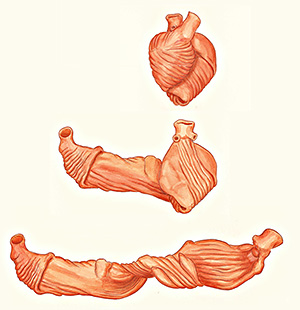
Fig. 1: The heart knot
The magnetic heart
Medical science has long known of the electrical signals emitted by the heart (ECG), but with the development of finer instruments it has been demonstrated that the heart also form the body's most powerful magnetic field. With a so-called SQUID magnetometer a magnetic field about 5000 times stronger than the brain’s can be detected up to 3-4 meters from a person’s heart. The magnetic field pulses and have the shape of a double torus (see Figure 2), which according to physicists is one of the most information-rich waveforms.
These phenomena may help to explain the many studies, showing that a person's heart clearly affects the hearts of other people nearby.
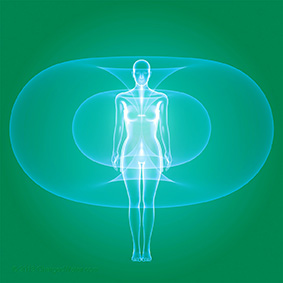
Fig. 2: The heart’s toroidal magnetic field
From heart to brain
Some researchers are introducing the term "heart brain" because it turns out, that the cardiac nervous system with approximately 40,000 neurons is much more complicated than previously thought: It can to a large extend function on its own and there are 10 times as many nerve fibers transmitting information from the heart to the brain than vice versa!
Psychological and parapsychological research suggest that the heart is able to sense and react to emotional events before our normal senses and the brain have perceived anything!
A pinched heart
Could it be that the heart can be physically squeezed by tensions and insufficient space in the mediastinum (the space in the middle of the chest between the lungst? With increasing time spent in front of computers and television many people develop, what is called a sterno-symphysal syndrome, which means reduced distance between the sternum and the pubic symphysis. A posture not unlike the cucumber on the label of Heidelberg vinegar!. This provides less room for the heart, and makes it harder for the heart muscle to do its work.
In yoga, many poses emphasize the concept of "revealing your heart" to open up the entire chest.
Reflexology that "reveals the heart"
In the reflexological session, it is also worth thinking about the chest when working with the heart. The connective tissue (fascia) of the chest is diverse and very strong, it continues in between the lungs and encloses the heart. It connects the front with the back (the sternum and spine) and top with the bottom (neck and respiratory diaphragm).
Begin by working reflexes for the sternum, and the thoracic spine, which are the strongest structures in the thorax. By working the first metatarsal carefully in its entire width, plantar and dorsal, you treat both structures at the same time.
Continue with the ribs. A good technique is to work with the four ulnar fingers (the thumb supporting on the plantar side) across the back of the foot from the first metatarsal (sternum), and deep into the tissue between the bones all the way to the fifth metatarsal (Figure 3).
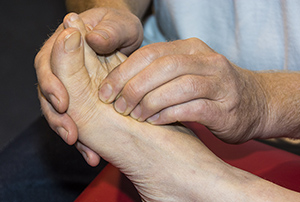
Fig. 3
Supplement by standing up with the back to the client and placing your two thumbs on top of two adjacent toes. The other fingers support below the same two toes. Then do a translational move, so that the two toes are shifted up and down (Figure 4). Continue with the next two toes, etc. Imagine you are "opening" and "closing" the chest, or twisting it back and forth, so that all fascia and joints are stretched and released.
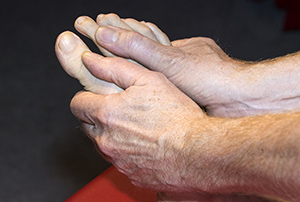
Fig. 4
Heart reflexes
When a person is standing upright the heart is located behind the sternum, level with the lower half of the thoracic spine (T4-T10). It rests on the diaphragm and projects slightly to the right of the sternum. On the left side the tip of the heart reaches a vertical line through the middle of the clavicle. When lying down the heart moves up 3-4 cm.
Figure 5 shows some of the heart reflexes we work with.
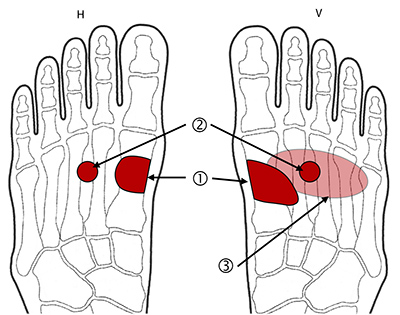
Fig. 5: 1) Touchpoint anatomical heart reflex (modified after Fitzgerald and Marquardt),
2) Heart reflex according to Karl-Axel Lind and Henrik Hellberg, 3) Eunice Inghams original heart reflex. (Plantar view)
A good method for reflexological treatment of the heart is to first relax all the structures around the heart with circular movements and then slowly approaching the heart reflex as the seed of a flower:
1) Start by working reflexes for the connective tissue of the septum (mediastinum), i.e. the entire area from T2 to T10, along and on the first metatarsal and the groove to the second metatarsal. Use fascia technique, which means deep, very slow strokes.
2) Continue with the pericardium (the area right around the heart reflex) still using fascia technique.
3) Finally, work the actual heart reflex. Try several different techniques. A nice relaxation technique is to hold a still, firm grip, both plantar and dorsal together and on both feet (Figure 6). Try simultaneously to sense the client's heart beat (most clearly felt on the dorsal side). If you cannot catch the pulse, or are unsure whether you feel your own, ask the client to find her own pulse at the wrist and count out loud.

Fig. 6: Relaxation of the heart
Synchronicity
The inventor of the pendulum clock Dutch Christian Huygens (1629-95) discovered that clocks placed near each other tend to synchronize so that all pendulums beat togehter. The strongest pendulum determines the pace.
This principle (entrainment) seems to apply to many rhythmic systems, also in biology. Man's strongest pulse generator is the heart, but not mechanical like a clock. Scientists have shown that the heart can synchronize or capture the rhythms of the other parts, but only when the mind is at rest. When thoughts are harmonious all rhythms synchronize!
These ideas are now being explored in the new discipline called chronobiology.
Learn more
There are many more techniques and more exciting new knowledge about the heart that we cannot fit into this article, such as: The heart as coordinator of all the physiological rhythms; the heart as an endocrine gland (secretes ANF, norepinephrine, dopamine, oxytocin, and more); and the emotional aspects of the heart.
For a long time we have been fascinated by the heart both as organ and as a concept, and how the latest bio science supports a broader view of the heart's key role as much more than a blood pump. That is why we have developed the latest training course for reflexologists "Round about: The Heart".
See more on www.touchpoint.dk/en
References
Maret, Karl: Exploring the Heart and Aether in Energy Medicine, Subtle Energies & Energy Medicine 20: 1 (2009) 53-96
Peters, Marcus: Gesundmacher Herz, VAK Freiburg, 2013
Lind Anna Kaarina: www.medikanova.fi
Hellberg, Henrik: www.teamhellbergzonterapi.com?
Ryesgade 27
DK-2200 Copenhagen N
Denmark
Tel: (+45) 2575 7047
Email >






